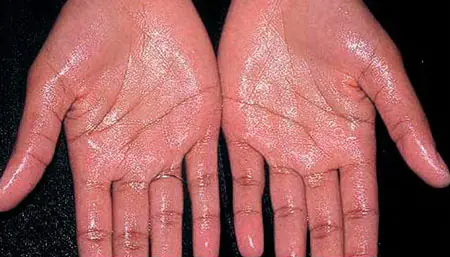Hyperhidrosis is manifested by profuse sweating. A person's palms, armpits, feet, and hands sweat. The disease is characterized by:
- presence of an unpleasant odor;
- fungal infection;
- bacterial infection.
An unpleasant odor appears due to a fungal infection of the skin of the feet. A person suffering from this disease is susceptible to skin diseases and frequent depression.
You can learn about the causes of excessive sweating from the video:
Kinds
There are two types of hyperhidrosis:
- Primary;
- Secondary.
Excessive sweating of the second type indicates the presence of a chronic disease in the patient. The disease can be caused by:
- presence of diabetes mellitus;
- hyperthyroidism;
- tuberculosis disease.
There are general and local hyperhidrosis. Excessive sweating of a general nature occurs when exposed to high temperatures, intense physical exertion or emotional experiences.
Increased local sweating is caused by:
- vegetative-vascular dystonia;
- tight shoes;
- clothing made from artificial materials.
With the local course of the disease, the palms, soles of the feet, and skin folds sweat.
Statistics. In every second patient, the disease is hereditary.
Symptoms
The first manifestations of the disease are observed during puberty. During this period, hormonal changes occur in the child’s body, he is in a state of stress, this increases the signs of the disease.
Signs of primary hyperhidrosis:
- profuse sweating in the armpit area;
- fungal skin infection;
- unpleasant smell.
Constantly wet skin is prone to frequent inflammation and irritation. Dermatitis accompanies hyperhidrosis. A concomitant disease with excessive sweating of the feet is a fungal infection of the skin, causing irritation, itching, accompanied by an unpleasant odor. Without proper treatment, the fungus affects not only the skin of the feet, but also the nails. This condition is characterized by general intoxication of the body.
Diagnostics
The purpose of diagnosis is to determine the nature of the disease and whether it is secondary. In this case, additional examination is necessary; it will identify the disease that provoked the development of hyperhidrosis in a person.
The specialist examines the clothing and examines sweat stains. The size of wet marks on the fabric in the armpit area will indicate the severity of the disease:
- With a mild degree, the size of the spot is no more than 10 cm.
- Moderate degree - no more than 20 cm.
- Severe degree – more than 20 cm.
Mild hyperhidrosis of the palms is characterized by slight moisture. A moderate degree is characterized by the appearance of drops on the fingertips. Streaks of sweat correspond to a severe form.
In addition to visual inspection, diagnosis is carried out using special methods:
- gravimetric;
- chromatographic;
- Minor's samples.
Treatment
The diagnosis is secondary hyperhidrosis, which requires mandatory treatment of the underlying disease that provoked the appearance of increased sweating.
When diagnosed with primary hyperhidrosis, the doctor prescribes complex therapy to the patient, which may include:
- drug treatments;
- diet;
- psychotherapy;
- radiation therapy;
- electrophoresis;
- surgical operation.
Drug treatment
The drug Botulinum toxin A is prescribed and administered intramuscularly. Has a blocking effect on sweat glands. The effect of use can last 3-6 months, but this is very individual. The drug does not work in some patients, usually in men.
Diet
It is recommended to exclude:
- spicy;
- salty;
- spices;
- coffee.
These are the foods whose consumption increases sweating. Following a diet for mild hyperhidrosis brings a noticeable positive effect.
Psychotherapy
The use of psychotherapeutic methods is necessary to improve mental state. In some cases, tranquilizers and sedatives are prescribed.
Radiation therapy
Radiation therapy improves the condition by briefly irradiating problem areas. The effect of using this method is short-lived. Radiation therapy may have a negative effect on the body.
Electrophoresis
Treatment is carried out using a special device. Low frequency currents affect problem areas. The course of treatment lasts more than one week. Relief occurs after the procedure. Possible side effects:
- allergy;
- irritation;
- itching;
- dermatitis.
Surgery
The surgical method is resorted to when there are no results from other types of treatment. There may be side effects with this method. During the operation, the sweat glands are destroyed and the nerve endings that affect them are severed.
You can see how axillary hyperhidrosis is treated on an outpatient basis.
Traditional methods
Traditional medicine methods are effective in the treatment of general and local hyperhidrosis.
Oak bark baths
Oak bark has long been used to reduce sweating. It is usually recommended to take baths with an infusion of oak bark. To prepare you will need:
- oak bark 1 tbsp. l;
- boiled water 1 l.
Bring to a boil, let simmer, remove from heat, leave for half an hour. Apply to the skin of the hands and feet.
Chamomile baths
To prepare you will need:
- talc;
- dried chamomile 7 tbsp. l;
- water boiling water 2 l.
Pour boiling water over chamomile. Close the pan tightly and leave for an hour. Make baths in the evening, treat your hands and feet with talcum powder in the morning.
Birch buds
Infuse birch buds with vodka. Use the tincture for wiping your armpits, legs, and arms. Repeat the procedure twice a day.
Prevention
Simple preventive measures will help avoid an unpleasant disease:
- Choose clothes that fit, made from natural materials.
- Take water procedures daily. A contrast shower is especially useful.
- Exercise.
- Eat properly. Reduce the amount of salty, spicy foods.
- Avoid stress.
Hyperhidrosis causes a lot of discomfort, but you can fight it.



